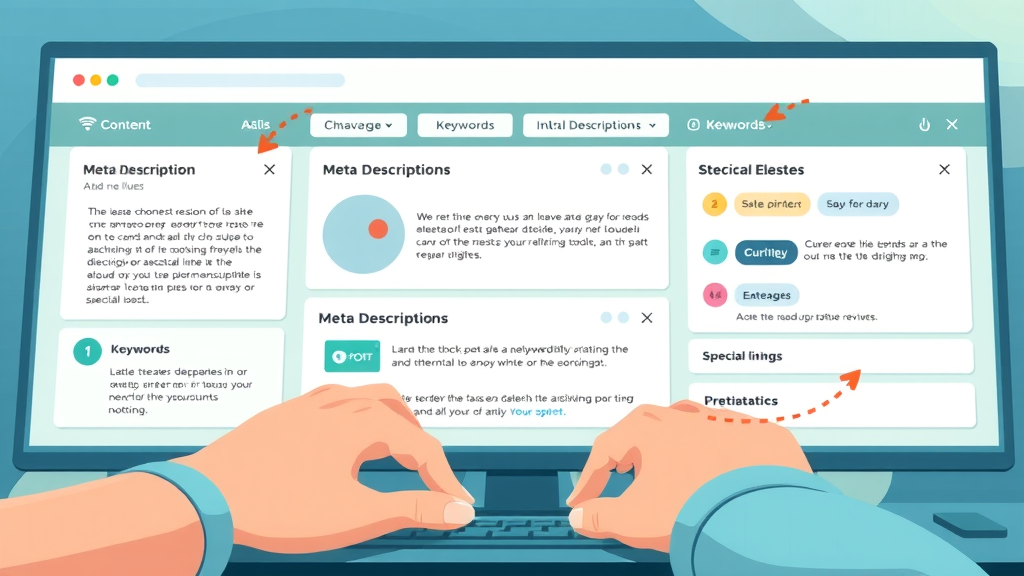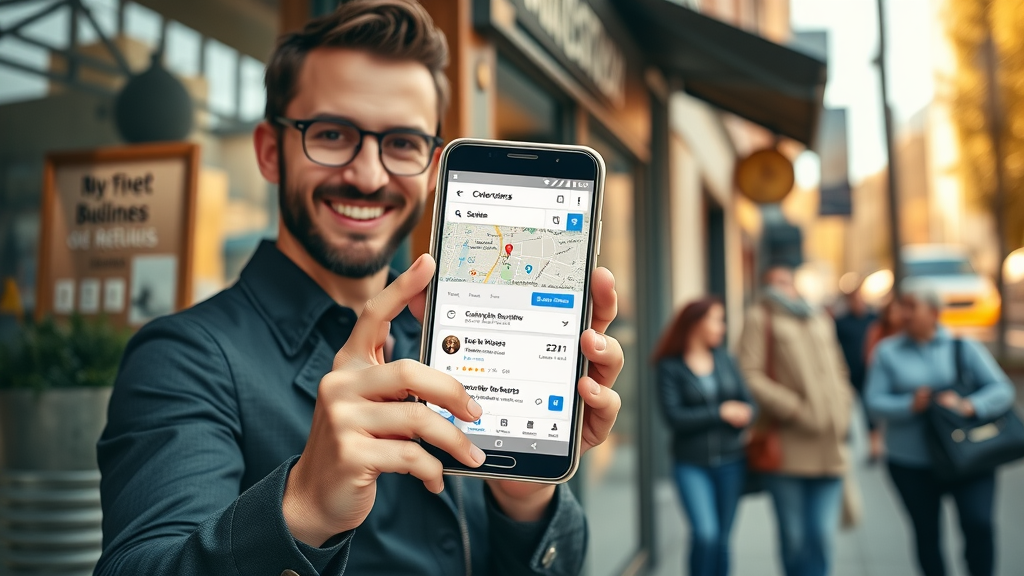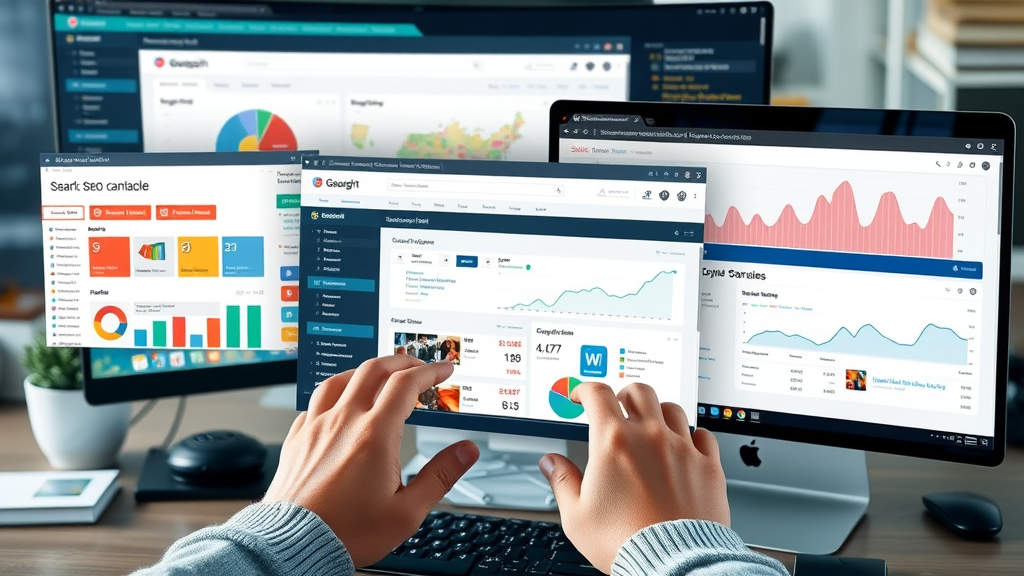First learn all about SEO. Then learn all the ways of getting on page 1 of search engines and then choose the one best for you, by way of ease, budget, rapidity of results and best yield for time and expense.
Did you know that more than 90% of online experiences kick off with a search engine? Whether you’re browsing for the latest gadgets, seeking nearby restaurants, or researching business solutions, nearly everyone begins with SEO-powered search. In an ever-connected world, understanding SEO isn’t just optional—it’s mission-critical for anyone wanting to rank high and stay visible in the digital marketplace. By the end of this guide, you’ll see precisely how SEO can elevate your online presence, drive organic traffic, and fuel real success. Ready to unravel the secrets behind the world’s most influential marketing strategy? Read on.
Revealing the Power of SEO: Why Over 90% of Online Experiences Begin with a Search Engine
SEO (Search Engine Optimization) is at the epicenter of the digital era, fundamentally shaping how users interact with businesses, content, and information. The reality is simple: the vast majority of journeys through the web start with a search engine such as Google, Bing, or Yahoo. This means your content, products, or services must be easily discoverable in search results —or risk fading into obscurity. With effective SEO strategies , you don’t just increase visibility; you position your site in front of ready-to-engage audiences exactly when they’re searching for what you offer.
Imagine the potential impact: landing on the first page of search results isn’t just a badge of honor—it unlocks streams of highly targeted, organic traffic. Brands and businesses with a mature SEO strategy outperform their competitors, convert more leads, and enhance long-term brand equity. As you dive deeper into this article, you’ll uncover how mastering search engine optimization is the catalyst for digital growth, higher conversion rates, and a resilient competitive edge in digital marketing .

Defining SEO: What Does Search Engine Optimization Mean?
At its core, SEO —short for Search Engine Optimization —is the practice of improving your website to increase its visibility when people search for products, services, or information via search engines. By understanding how search engines operate and what users are seeking, you tailor your site and content to achieve better rankings in engine results pages (SERPs). But SEO is far more than inserting a few keywords; it’s a holistic process involving on-page SEO , off-page SEO , technical SEO , and even local SEO .
SEO empowers websites large and small to rank higher and capture quality organic traffic —the cornerstone of sustainable online growth. By leveraging the right SEO tools and strategies, you transform your site into a trusted online resource. Search engines reward relevancy, authority, and seamless user experience—so optimizing for these elements is essential for digital success. Whether you’re a beginner or a seasoned SEO pro , understanding these fundamentals is the first step toward becoming an SEO expert .
Key Insights: What You'll Gain by Mastering SEO
-
A detailed understanding of SEO fundamentals
-
How search engines rank content and the critical factors influencing SEO
-
Steps to implement effective SEO strategies and use powerful SEO tools
-
Differences between on-page SEO, off-page SEO, technical SEO, and local SEO
-
How to drive organic traffic and enhance user experience
-
Answers to popular questions such as how SEO impacts digital marketing
How Search Engines Work: The Backbone of SEO
Understanding how search engines function is fundamental to SEO . Search engines serve as massive digital librarians, constantly scanning, organizing, and retrieving web content to deliver the most relevant results to user queries. By grasping the technical SEO processes behind this, you can tailor your site to meet and exceed ranking criteria.
Effective engine optimization is built on this backbone: the better you align with search engines’ assessment methods, the greater your likelihood of securing top placement in search engine results . As we continue, you’ll see how SEO strategies are rooted in understanding—and working with—the algorithms that power search engines and dictate engine ranking .
The Fundamental Algorithm: Crawling, Indexing, and Ranking
Crawling is the process where search engines deploy bots (often nicknamed spiders) to scan websites for updated content. These bots discover new pages, follow internal links , and gather relevant information. Once content is found, it moves to the indexing stage where it’s stored and organized in the search engine’s massive database. Finally, ranking comes into play—the stage where search engines determine which indexed content best answers a user’s query, factoring in content quality, relevance, and authority.
To succeed in SEO , your content needs to be easily crawlable and indexable. Well-structured pages, effective on-page SEO , and clear internal links make it easier for bots to understand your website. Optimizing these steps boosts your chances of achieving a high search engine ranking , increasing your visibility in organic search results.

Why Search Engine Algorithms Evolve
Search engine algorithms are in a constant state of evolution. Initially, algorithms focused on simple keyword matching and basic site authority. Today, modern search engines consider hundreds of ranking factors, emphasizing user intent, mobile-friendliness, page speed, and high-quality content. This evolution ensures users receive the most relevant, trustworthy, and valuable results—raising the bar for SEO pros everywhere.
Adapting to these changes is central to every successful SEO strategy . Each update—large or small—demands that webmasters and marketers continually refine their practices. Investing in ongoing learning, tracking search engine trends, and using up-to-date SEO tools are essential to outpacing competitors and maintaining impactful engine rankings .
|
|
|
Key Search Engine Ranking Factors |
|
On-Page SEO |
Off-Page SEO |
Technical SEO |
|---|---|---|
|
Content Quality |
Backlinks |
Site Speed |
|
Meta Tags |
Social Signals |
Mobile Friendliness |
|
Internal Linking |
Domain Authority |
Crawlability |
Core Components of SEO: What Every SEO Pro Should Know
Succeeding at SEO means understanding its core components : On-page SEO, Off-page SEO, Technical SEO, and Local SEO. These areas work together to maximize your site's search engine ranking and deliver exceptional user experience. Whether you’re aiming to rank high on a competitive national keyword or dominate local SEO searches in your neighborhood, mastering these pillars is essential for every SEO expert .
By implementing best practices for each component, you create a site that search engines readily index, users enjoy navigating, and competitors struggle to outmatch. The key isn’t just doing more—it’s understanding which strategies move the needle for your specific goals.
On-Page SEO: Optimizing Your Content and Structure
On-page SEO focuses on optimizing elements within your own website. This includes crafting high-quality, keyword-rich content, writing compelling meta descriptions, structuring headings for clarity, and ensuring multimedia enhances—not distracts from—the message. It also means optimizing internal links so search engines easily crawl related pages, fostering both site authority and user navigation.
Each web page you publish should align with best practices: use primary and secondary keywords naturally, structure your content for readability, and enhance user engagement with visuals and interactive elements. Effective on-page SEO is more than a checklist—it’s a creative discipline that combines search intent, technical know-how, and great storytelling to win in search engine results .

Off-Page SEO: Building Authority Beyond Your Site
Whereas on-page efforts focus on your site itself, off-page SEO revolves around building your website’s reputation and authority through external factors. The most important of these is link building —gaining high-quality backlinks from other reputable websites. Every backlink acts as a vote of confidence, signaling to search engines that your content is trustworthy and valuable.
Other off-page signals include social mentions, brand mentions, and participation in authoritative platforms. Effective off-page SEO broadens your digital footprint, helping you rank higher in search engines and compete for challenging keywords. Remember, successful SEO strategy strikes a balance between both on- and off-page optimization.

Technical SEO: Creating a Seamless Site Experience
Technical SEO is the backbone ensuring your site’s foundation is strong. It involves optimizing website architecture, enhancing site speed, implementing secure protocols (HTTPS), and making your web pages mobile-friendly. Search engines prioritize technical excellence—if your site loads slowly, isn’t mobile-responsive, or has crawl errors, your rankings and user experience will suffer.
Prioritize running regular technical audits using top SEO tools , fixing broken links, improving server response times, and organizing sitemaps/robots.txt files. This not only makes it easy for search engines to index your website, but also provides a smoother experience for users—two goals every SEO pro should pursue relentlessly.
Local SEO: Dominating Google Search in Your Area
Local SEO is an essential subset of search engine optimization tailored toward helping businesses rank higher in local search results. For brick-and-mortar stores, restaurants, services, or any business serving a specific region, local SEO can drive foot traffic and online conversions directly from map listings or “near me” queries.
Optimizing for local means claiming your Google Business Profile, gathering positive customer reviews, using location-specific keywords, and building local citations. By customizing your approach, you become the go-to business in your community every time a user turns to Google Search for something nearby.

Establishing a Winning SEO Strategy: Steps to Rank Higher
Developing a robust SEO strategy means combining meticulous research, technical skill, and ongoing analysis. To rank higher in search engine results, you must approach SEO as a dynamic, iterative process. Start with understanding your target audience and what they’re searching for—this forms the bedrock of your optimization journey.
Each step— keyword research, on-page optimization, link building, content creation —must be strategic and informed by data. Successful websites treat SEO not as a “set and forget” action, but as the heartbeat of every online initiative, evolving as algorithms and user needs change.
Conducting Strategic Keyword Research
Keyword research is where every effective SEO campaign begins. By identifying terms and phrases your audience is searching, you can shape your content to meet their needs and solve their problems. Invest in advanced SEO tools to uncover high-volume, low-competition keywords and find long-tail opportunities that drive targeted, high-intent visitors.
Prioritize search intent—what are users really hoping to find when they enter a query? Aligning your content to this intent increases your odds of a top engine ranking . Brainstorm, analyze, and validate every keyword strategy before diving into content creation to maximize your site’s organic impact.

On-Page and Off-Page SEO Techniques for Engine Optimization
Once you’ve mapped out your keywords, it’s time to optimize both on- and off-page factors for full-spectrum engine optimization . On-page, this means refining your titles and meta descriptions, utilizing header tags, and interlinking related content. Off-page, focus on building authoritative backlinks and engaging with your audience on social media to boost your domain authority.
Consistently measure the impact of each adjustment with analytics tools to fine-tune your SEO strategy . The interplay of internal links , fresh content, and a healthy backlink profile is proven to cement site authority, helping you earn coveted spots in search engine results .
Leveraging Analytics with Google Search Console
No modern SEO initiative succeeds without deep data analysis—and the free Google Search Console is one of the most invaluable SEO tools at your disposal. This platform offers actionable insights into how your site performs in search, highlighting indexing issues, keyword ranking positions, site errors, and user engagement signals.
Leverage this data to identify trends, troubleshoot problems, and uncover new opportunities for optimization. When effectively used, Google Search Console becomes the pulse of your SEO health, empowering your website to climb search rankings methodically and efficiently.

-
Perform technical SEO audits regularly
-
Create high-value, original content
-
Optimize URLs, internal links, and site speed
-
Pursue quality backlink opportunities
-
Focus on mobile friendliness and user experience
SEO Tools and Resources Every SEO Expert Should Use
Choosing the right SEO tools can supercharge your optimization efforts. From deep keyword research platforms to backlink analysis and rank tracking, modern solutions help you make informed, data-driven decisions. SEO experts rely on a toolkit that covers every aspect—keyword discovery, site auditing, competitor benchmarking, and performance monitoring.
The most successful SEO pros combine a handful of trusted platforms, each serving a unique function in building, monitoring, and refining their SEO strategy . Below are some essential tools every site owner should consider adding to their arsenal.
Top SEO Tools for Successful Optimization
1. Google Search Console – Essential for tracking site performance, detecting issues, and monitoring search engine ranking progress. 2. Ahrefs – Leading backlink and competitor analysis platform with robust tracking and exploration features. 3. SEMrush – Comprehensive all-in-one SEO tool for keyword research, site auditing, and competitive insights. 4. Moz Pro – Trusted for on-page analysis and providing actionable grades for web page optimization.
Each of these platforms brings distinct benefits—ranging from daily monitoring, deep-dive competitor evaluation, to grading your on-page SEO efforts. Experiment with combinations to discover what provides the most actionable data for your website’s unique journey.

|
|
|
Top SEO Tools Comparison |
|
SEO Tool |
Purpose |
Unique Feature |
|---|---|---|
|
Google Search Console |
Site performance |
Monitor indexing/issues |
|
Ahrefs |
Backlink analysis |
Robust link tracker |
|
SEMrush |
Keyword research |
Competitor insight |
|
Moz Pro |
On-page SEO |
Page optimization grading |
SEO in the Context of Digital Marketing
SEO doesn’t exist in a vacuum. It’s a cornerstone discipline in digital marketing , influencing and being influenced by social media marketing, content strategy, paid search, and analytics. A truly effective SEO strategy ensures seamless integration across all channels—building a consistent brand experience that delights users wherever they engage.
In today’s landscape, understanding the relationship between SEO , social platforms, and web content is critical. It’s this interplay that amplifies your reach, increases your authority, and unlocks the real potential of modern digital marketing .
How SEO Integrates with Social Media and Content Marketing
Your website’s SEO performance often correlates with your activities on social media and with the quality of your content marketing. Sharing optimized blog posts on platforms like Facebook, LinkedIn, or Instagram drives both direct traffic and valuable social signals that reinforce your site’s authority in search engine algorithms. Effective internal links within your content further guide users and search engines alike to your most important pages.
A powerful digital marketing plan aligns SEO fundamentals, engaging content, and strategic social sharing. This synergy not only boosts organic traffic but also solidifies your reputation as a trusted subject matter expert—key for outperforming in competitive search results .

Using SEO to Drive Long-Term Organic Traffic
Unlike paid campaigns that stop when your ad spend dries up, SEO builds lasting momentum that delivers organic traffic over time. High-quality, evergreen content optimized for search engines continues to attract visitors, leads, and customers long after it’s published. This makes SEO one of the most cost-effective tactics in a holistic digital marketing strategy.
Commit to providing genuine value and addressing user intent at every touchpoint—doing so ensures your web pages consistently appear at the top of search engine results , generating continuous growth and return on your investment.
Maximizing User Experience for Better Search Engine Ranking
A stellar user experience is now central to search engine ranking . Search engines want to deliver results that are not only relevant but also enjoyable to interact with. Fast load times, mobile optimization, clear navigation, and quality content all signal to algorithms that your site deserves a higher spot in engine results .
From the user’s first click to their last scroll, every interaction shapes their perception of your brand. Prioritizing user experience doesn’t just reduce bounce rates; it boosts organic search visibility and conversion rates alike.
The Interplay Between User Experience and Organic Search
A seamless website fosters trust and encourages visitors to stay longer—key metrics that influence search engine optimization . Elements like logical site structure, mobile-friendly design, and clear calls-to-action all impact how users and search engines interpret your content.
Proper internal links guide readers effortlessly from one page to the next, while optimized images, headings, and load times remove barriers to engagement. In essence, the user experience you create sets the stage for higher search engine rankings and sustained audience growth through organic traffic .

-
Improve page load speed
-
Design mobile-optimized layouts
-
Use clear navigation and internal links
-
Create content for user intent
Real-World Case Studies: Demonstrating the Impact of SEO
The proof is in the results—businesses in every sector are reaping tangible rewards from prioritizing SEO . Case studies consistently show that investing in solid SEO strategy leads to exponential growth in organic traffic , increased leads, and dramatic improvements in search engine ranking .
From local businesses claiming the top “near me” spot, to e-commerce platforms boosting sales through technical SEO fixes, real-world examples reinforce the transformative power of search engine optimization. As you employ the concepts in this guide, these successes can become your own.
How Businesses Achieved Page One Rankings
A technology startup increased its web leads by 200% after optimizing on-page content and executing a successful link building campaign. A restaurant chain saw a 50% surge in reservations after focusing on local SEO and gathering more online reviews. Even small e-commerce brands have doubled their sales after conducting a comprehensive technical SEO audit and speeding up their websites.
These diverse stories underscore a single, universal truth: excellence in SEO correlates directly with measurable business gains.
"Good SEO is about being the best answer to someone’s search question." – Rand Fishkin
Common SEO Challenges and How to Overcome Them
Every SEO expert faces roadblocks, from unpredictable search engine algorithm changes to persistent technical issues. The key to thriving is learning how to adapt, troubleshoot, and continuously refine your tactics. Stay informed, test new strategies, and treat challenges as opportunities to gain a competitive advantage.
By embracing a mindset of agility and curiosity, you’ll be equipped to resolve issues quickly and maintain top search engine rankings —no matter what the algorithms throw your way.
Adapting to Algorithm Updates
Major search engines constantly revise their algorithms to enhance user satisfaction and weed out manipulative tactics. Staying ahead means subscribing to industry blogs, following official search engine updates, and proactively adjusting your SEO strategy .
Successful SEO pros know the importance of monitoring site metrics after every update. Keep your content high-caliber and your practices ethical to avoid penalties—and remember, slow and steady improvements often yield the best long-term rewards.
Troubleshooting Technical SEO Problems
Technical SEO issues, such as broken internal links , crawl errors, and slow load times, can cripple your visibility. Routine site audits and prompt fixes are essential. Use advanced SEO tools and Google Search Console to flag and resolve issues before they impact rankings.
When in doubt, review best practices for mobile optimization, schema markup, and secure site protocols. Even small technical refinements can move the needle significantly for search engine optimization .

People Also Ask: Top SEO Questions Explained
What does SEO mean?
SEO stands for Search Engine Optimization. It’s the process of improving your website and content so that they appear higher in search engine results for relevant queries. Effective SEO strategy increases visibility, drives more organic traffic, and helps you reach your digital marketing goals.
What are the 4 types of SEO?
The four core types of SEO are: On-Page SEO (optimizing content and site structure), Off-Page SEO (building backlinks and authority), Technical SEO (improving site infrastructure and performance), and Local SEO (optimizing for region-specific visibility, especially for businesses with physical locations).
How does SEO work in marketing?
SEO integrates with digital marketing by making your business more discoverable to potential customers who are searching for your solutions online. By ranking higher in engine results pages, you attract targeted visitors, build trust, and create opportunities for conversions—all of which contribute to broader marketing success.
What is an SEO salary?
Salaries for SEO specialists can vary based on experience, location, and expertise. Entry-level positions in the United States typically start around $40,000 to $50,000 per year, while seasoned SEO experts and managers can earn $70,000 to $100,000+ annually, especially within agencies or larger corporations.
Essential SEO Tips: Best Practices to Rank Higher
-
Optimize for search intent and user experience
-
Focus on keyword research and content quality
-
Build high-authority backlinks consistently
-
Monitor metrics and adjust your SEO strategy
-
Utilize advanced SEO tools and analytics
Future of SEO: Trends and What to Expect
The future of SEO will be shaped by advancements in voice search, artificial intelligence, and machine learning. As user behavior shifts, algorithms will further enhance personalization, semantic search accuracy, and natural language processing, making content optimization even more nuanced.
Staying ahead involves adopting emerging best practices, experimenting with new formats like video and voice, and always focusing on delivering outstanding user experiences . The leaders in tomorrow’s search environment will be those who innovate today.
Voice Search, AI, and Machine Learning in Search Engine Optimization
Voice assistants such as Alexa, Google Assistant, and Siri are revolutionizing how users interact with search engines. Optimizing content for conversational queries, local intent, and direct answers is already a best practice. Meanwhile, machine learning algorithms interpret context and user engagement signals more deeply than ever before, requiring continuous refinement of SEO strategies .
AI-based tools are now essential for speedy competitor research, keyword clustering, and even automated technical SEO audits. Embrace these technologies to remain competitive as digital landscapes shift.

Preparing Your SEO Strategy for Ongoing Success
Proactive planning ensures your SEO strategy remains effective amidst ongoing updates and shifting user expectations. Prioritize mobile-first design, continuously refresh content, and invest in skill development to stay on top in the ever-evolving world of search engine optimization .
Frequently Asked Questions About SEO
-
How long does it take to see SEO results? Most websites start to see measurable improvements within 3–6 months of consistent SEO effort, but competitive niches may take longer for top rankings.
-
What are the most important Google Search ranking factors? Key factors include high-quality, relevant content, authoritative backlinks, site speed, mobile friendliness, and technical optimization.
-
Can SEO replace paid advertising? While SEO can deliver sustainable organic traffic and leads, it’s most powerful when combined with strategic paid campaigns, especially for brand-new sites or urgent promotions.
-
What are the risks of Black Hat SEO? Black Hat SEO involves manipulative tactics that violate search engine guidelines. These can result in heavy penalties or bans, so always prioritize ethical, White Hat strategies.
Summary and Action Steps for SEO Success
Apply the techniques in this guide—research, optimize, analyze, and adapt—to move your website toward the top of search engine results and unlock real business growth.
Ready to Dominate Page 1?
If this was all too much, get in touch to learn to dominate SEO the easy way.
Connect at SEOExpertlyUS.com to learn your easy way to page1.
S.Raj MD Editor-in-Chief at Scores Publishing
Scores Media Productions
30721 Russell Ranch Rd Suite 140,
Westlake Village, CA 91362
Connect with me on LinkedIn at: https://www.linkedin.com/in/scores1/
Sources
-
https://moz.com/beginners-guide-to-seo – Moz: Beginner’s Guide to SEO
-
https://searchengineland.com/guide/what-is-seo – Search Engine Land: What is SEO?
To deepen your understanding of SEO, consider exploring the following authoritative resources:
-
Google’s Search Engine Optimization (SEO) Starter Guide offers comprehensive best practices to enhance your site’s visibility and performance in search results.
-
Ahrefs’ article “What is SEO and Why Does It Matter for Your Website?” provides insights into the significance of SEO and practical strategies to improve your site’s search engine rankings.
These resources will equip you with the knowledge and tools necessary to effectively optimize your website and achieve your digital marketing objectives.
 Add Row
Add Row  Add
Add 



Write A Comment